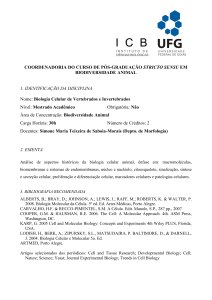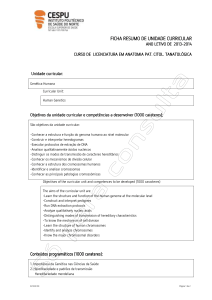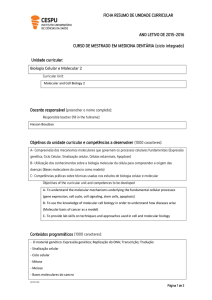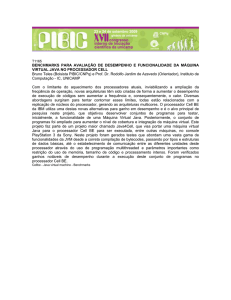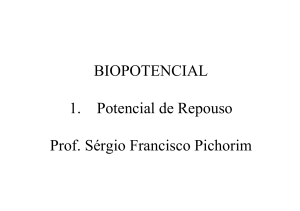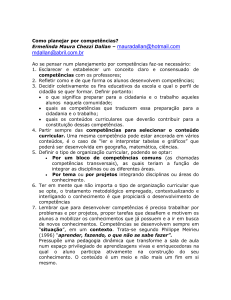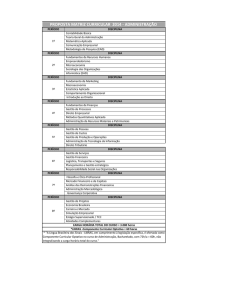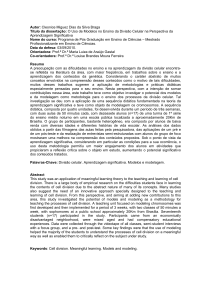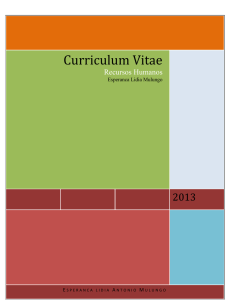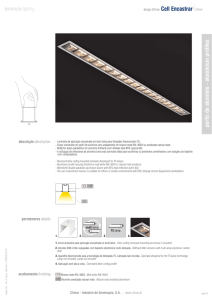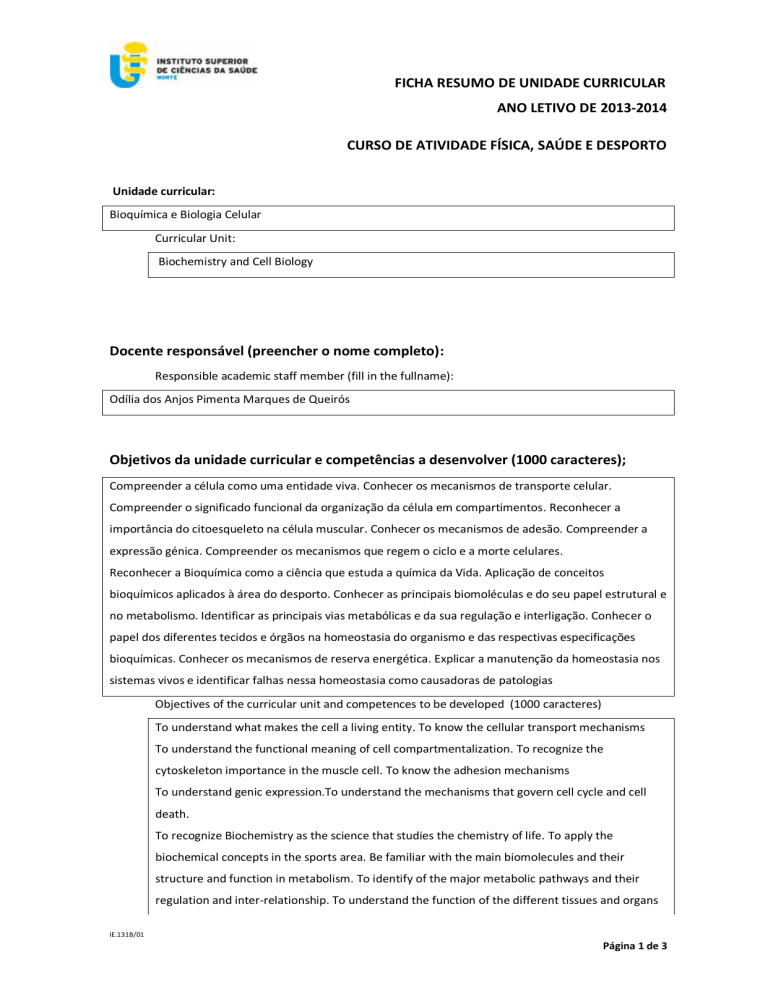
FICHA RESUMO DE UNIDADE CURRICULAR
ANO LETIVO DE 2013-2014
CURSO DE ATIVIDADE FÍSICA, SAÚDE E DESPORTO
Unidade curricular:
Bioquímica e Biologia Celular
Curricular Unit:
Biochemistry and Cell Biology
Docente responsável (preencher o nome completo):
Responsible academic staff member (fill in the fullname):
Odília dos Anjos Pimenta Marques de Queirós
Objetivos da unidade curricular e competências a desenvolver (1000 caracteres);
Compreender a célula como uma entidade viva. Conhecer os mecanismos de transporte celular.
Compreender o significado funcional da organização da célula em compartimentos. Reconhecer a
importância do citoesqueleto na célula muscular. Conhecer os mecanismos de adesão. Compreender a
expressão génica. Compreender os mecanismos que regem o ciclo e a morte celulares.
Reconhecer a Bioquímica como a ciência que estuda a química da Vida. Aplicação de conceitos
bioquímicos aplicados à área do desporto. Conhecer as principais biomoléculas e do seu papel estrutural e
no metabolismo. Identificar as principais vias metabólicas e da sua regulação e interligação. Conhecer o
papel dos diferentes tecidos e órgãos na homeostasia do organismo e das respectivas especificações
bioquímicas. Conhecer os mecanismos de reserva energética. Explicar a manutenção da homeostasia nos
sistemas vivos e identificar falhas nessa homeostasia como causadoras de patologias
Objectives of the curricular unit and competences to be developed (1000 caracteres)
To understand what makes the cell a living entity. To know the cellular transport mechanisms
To understand the functional meaning of cell compartmentalization. To recognize the
cytoskeleton importance in the muscle cell. To know the adhesion mechanisms
To understand genic expression.To understand the mechanisms that govern cell cycle and cell
death.
To recognize Biochemistry as the science that studies the chemistry of life. To apply the
biochemical concepts in the sports area. Be familiar with the main biomolecules and their
structure and function in metabolism. To identify of the major metabolic pathways and their
regulation and inter-relationship. To understand the function of the different tissues and organs
IE.131B/01
Página 1 de 3
FICHA RESUMO DE UNIDADE CURRICULAR
in the body homeostasis and their biochemical specifications. Be familiar with the mechanisms of
energy reserves. To explain the maintenance of homeostasis in living systems and identify
disorders of that homeostasis as causing diseases
Conteúdos programáticos (1000 caracteres):
A célula eucariótica
Membranas biológicas
Compartimentos intracelulares e tráfico de proteínas
Citoesqueleto
A célula muscular
Junções intercelulares
O fluxo da informação genética
Ciclo celular, mitose e meiose
Apoptose
Biomoléculas. Aminoácidos e proteínas, hidratos de carbono, lípidos, ácidos nucleicos. Estrutura e função
biológica.
Enzimas e reações biológicas.
Estudo de proteínas fisiologicamente importantes. Hemoglobina, mioglobina e colagénio.
Princípios de bioenergética e oxidação biológica. Stress oxidativo.
Metabolismo. Principais vias metabólicas. Metabolismo de hidratos de carbono, lípidos e proteínas, .
Regulação e Integração metabólica.
Princípios de nutrição.
Homeostasia da glicose. Interrelações metabólicas dos tecidos em diferentes estados.
Função especializadas de órgãos e tecidos.
Alterações metabólicas na doença hepática, na doença renal e na diabetes.
Metabolismo de xenobióticos.
Adaptação metabólica no exercício físico aeróbico e anaeróbico.
Doping.
Syllabus (1000 caracteres)
The eukaryotic cell
Biological membranes
Compartmentalization of the cell and protein traffic
Cytoskeleton
Muscle cell
Cell junctions
The flow of genetic information
Cell cycle, mitosis and meiosis
IE.131B/01
Página 2 de 3
FICHA RESUMO DE UNIDADE CURRICULAR
Apoptosis.
Biomolecules. Principal groups of biomolecules found in human tissues. Aminoacids and proteins,
carbohydrates, lipids and nucleic acids. Structure and biological function.
Enzymes and biological reactions.
Physiologically important proteins. Hemoglobin, myoglobin and collagen.
Principles of bioenergetics and biological oxidation. Oxidative stress.
Metabolism. Major metabolic pathways. Metabolism of carbohydrates, lipids and proteins, .
Regulation and metabolic integration.
Principles of nutrition.
Glucose homeostasis. Inter-relationships of metabolic tissues in different states.
Specialized function of organs and tissues.
Metabolic alterations in hepatic and renal diseases and in Diabetes.
Metabolism of xenobiotics.
Metabolic adaptation in anaerobic and aerobic exercise.
Referências bibliográficas (máximo três títulos):
Quintas, A., Ponces-Freire, A., Halpern, M.J. “Bioquímica – Organização molecular da vida. Lidel, 1ª Ed.
2008.
Baynes, J.W., Dominiczak, M.H. “Medical Biochemistry”. Elsevier Mosby, 2ª Ed. 2005.
Cooper, G.M., Hausman R.E. The Cell: A Molecular approach. 5ª Ed. ASM Press, Washington. 2009
O regente (data e assinatura):
IE.131B/01
Página 3 de 3

